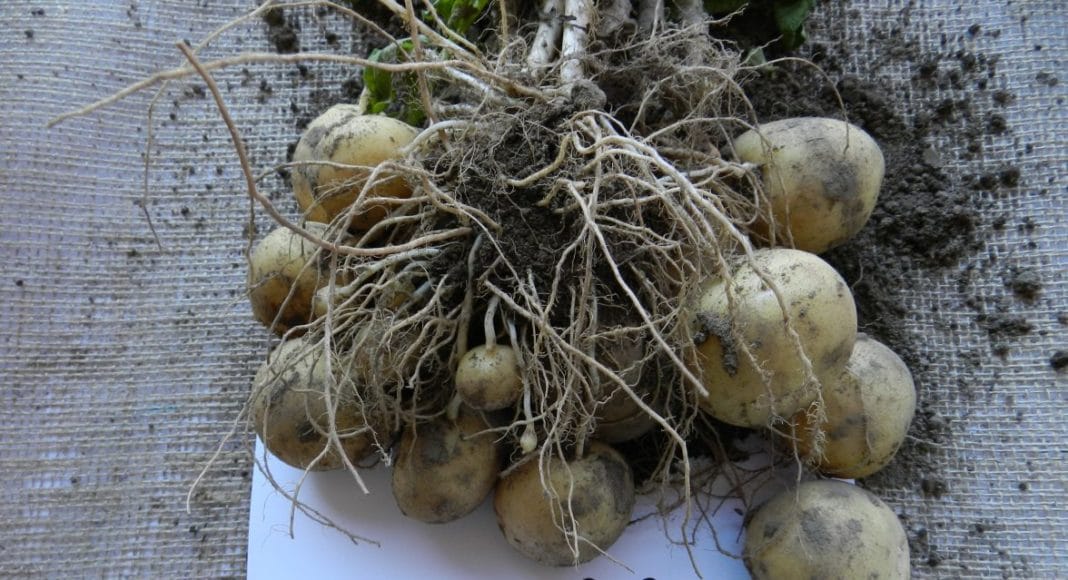[deck]Recent developments in table stock and chipping options.[/deck]
Improving mashed potatoes is no easy feat, but breeders around the world are doing just that.
At the Ontario Potato Board’s annual field day in August, several new table stock varieties were unveiled to a large crowd of growers, industry personnel and researchers.
By far the variety garnering the most interest was Electra, a large round, yellow-skinned and yellow-fleshed variety developed by IPM Potato Group of Ireland. Introduced in Canada by Real Potatoes, the variety holds promise for Canadian production.
Electra is a widely adapted variety, says Don Northcott of Real Potatoes Ltd. The Prince Edward Island company has evaluated Electra in trials across Canada and the U.S., and it has produced well in all conditions and areas. “We’ve found that it is highly drought tolerant and that it seems to have high resistance to common scab.”
Of interest to producers is Electra’s high yield – 15 or more tubers per plant – and its uniform size. Northcott says seed should be available in 2017. In 2016, Electra seed was a sell out and demand has increased, so he is unsure if enough will be on hand for next year.

Photo: Rosalie I. Tennison
“Electra has been on the market for 10 years in Europe, and we feel it will do well in Canada,” says Graeme Prentice of IPM Potato Group, who attended the field day in support of the variety. “It’s well-adapted to long and short day length, and withstands drought and high temperatures. It’s extremely robust agronomically, and its excellent uniformity and low out-grades ensure it is a firm favourite with growers, packers and retailers.”
Real Potatoes also promoted other varieties that are relatively new to the market and which the company believes have a place in Canadian potato production. In the table varieties, Actrice is another yellow-skinned, yellow-flesh potato developed by a hobby breeder in The Netherlands. Northcott says about 90 per cent of the crop will make it to market. Actrice has been grown across Canada and in several U.S. states over the last couple years. He adds it interests growers looking for an early maturing variety.
A Canadian variety, Alta Strong, is a good option for the fresh cut fry market with its high yield and very long white tubers. “It would be a good variety for use in food trucks.”
Northcott says Real Potatoes watches for trends in the market and in consumer interest, and then the company searches the world for varieties to test in Canada that might satisfy the identified needs. “For example, Electra and Actrice have wide application and would interest many growers,” he notes. “We have an exhaustive variety trial process in Canada and the United States. We have fewer varieties, but we know a lot about each one and can offer technical information to help growers make decisions.”
Other seed companies were also on hand to showcase their varieties new and old. As well, the results of the Ontario Potato Board’s trials were available for growers to study. Company representatives were on hand to answer questions about production and end use.
HZPC Americas launched a couple new varieties while showcasing some of their standards. In particular, growers were interested in Panamera, a strong high-yielding variety with “eco-friendly and sustainable qualities.” It has smooth yellow skin and bright yellow flesh with good resistance to late blight and common scab. Panamera is also resistant to heat stress and requires lower amounts of nitrogen.
In a media release, the Ontario Potato Board also touted HZPC’s Primabelle, another yellow-fleshed variety, and Double Fun, a purple variety with an impressive skin. Primabelle has a uniform tuber size and shape and is early maturing with a high yield. Of particular interest, it has good resistance to Rhizoctonia.
With over 100 varieties on display, producers had many comparisons to make. Varieties from smaller companies could be compared to those offered by the bigger seed producers, and unbiased comparisons were shared by the researchers who grow the many varieties in test plots on behalf of the potato board. Also on hand were companies offering pest and disease control products, equipment and tools to make potato production more efficient.
As newer potato varieties are introduced, cooking and production qualities are enhanced. These are no longer Grandma’s mashed potatoes.











